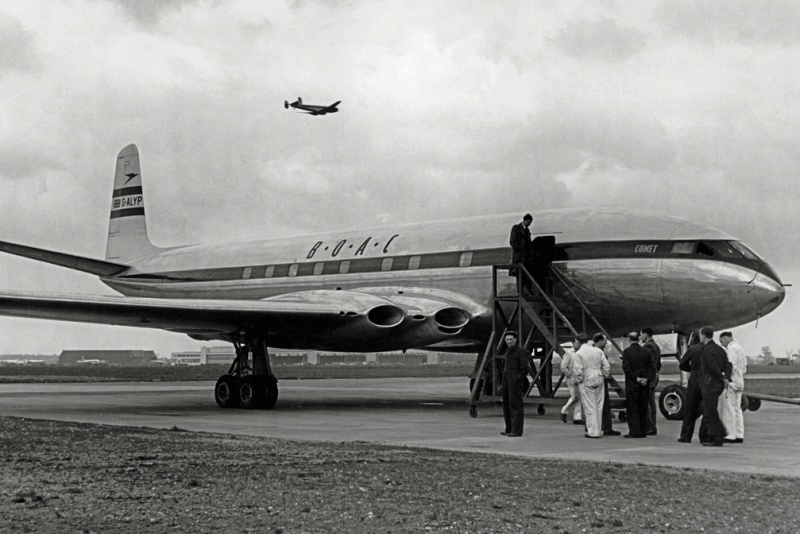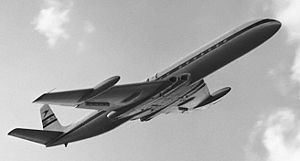
Comet Crash 1954
A BOAC de Havilland Comet 1,similar to the accident aircraftOccurrenceDate8 April 1954SummaryIn-flight metal fatigue failure leading to explosive decompression & break-upSiteMediterranean Sea between and:AircraftAircraft typede Havilland DH 106Comet 1Operatoron behalf ofG-ALYYFlight origin, England1st stopover, ItalyLast stopover, EgyptDestination,Passengers14Crew7Fatalities21Survivors0South African Airways Flight 201 ( SA201), a, took off at 18:32 on 8 April 1954 from in, Italy, en route to, Egypt, on the second stage of its flight from, England to, South Africa. The flight crashed at around 19:07 UTC, killing all on board. The flight was operated as a charter by (BOAC) using the aircraft G-ALYY ('), with a South African crew of seven, and carrying fourteen passengers.
Contents.Flight and disaster Gerry Bull and other BOAC engineers examined the aircraft for Flight 201. Previously, the same team had examined (a Comet that had broken up at altitude in January 1954) prior to its final flight.Flight 201 took off from London for Rome at 13:00 UTC on Wednesday 7 April 1954, on the first leg southwards to Johannesburg, arriving at Rome approximately two and a half hours later, at 17:35 UTC. On arrival at Rome engineers discovered some minor faults, including a faulty fuel gauge and 30 loose bolts on the left wing, which delayed the aircraft's departure by 25 hours before Yoke Yoke was ready to depart for Cairo on the evening of Thursday 8 April.The aircraft took off for Cairo at 18:32 UTC under the command of Captain William Mostert, and climbed rapidly towards its cruising height of 35,000 feet (11,000 m).

The crew reported over the beacon at 18:37 UTC, passing through the altitude of 7,000 feet (2,100 m). Disgaea 2 dark hero days iso download. The weather was good, but with an overcast sky.Another report was made from the aircraft, first at 18:49 UTC at, where it reported climbing through 11,600 feet (3,500 m) and another at 18:57 UTC when it reported passing abeam of Naples. At 19:07 UTC, while still climbing, the aircraft contacted Cairo on the long range radio and reported an of 21:02 UTC.This was the last message heard from Yoke Yoke as some time later, the aircraft disintegrated in the night sky at around 35,000 feet (11,000 m), killing everyone on board.After repeated attempts at re-gaining contact by both Cairo and Rome air traffic control were made and went unanswered, it was realised that another Comet had been lost. Initial news of the accident was leaked to the press by a German radio station which had been monitoring the radio transmissions.The wrote thatBritain today weighed the cost of a stunning blow to her proudest pioneer industry – jet civil aviation – as the crash of another Comet airliner was confirmed. Twenty-one persons, including three Americans, were believed to have died when the plane was lost in the Mediterranean.
The discovery of at least six bodies and bits of wreckage floating in the sea about 70 miles (110 km) south of Naples put a pall on the last hopes for the British Overseas Airways Corporation craft, missing since 6:57 o'clock last night.Tonight the Minister of Transport, withdrew from all Comets the that the aircraft won on 20 January 1952, 'pending further detailed investigations into the causes of the recent disasters.' This second, unexplained Comet crash in three months came less than three weeks after the sleek four-jet de Havilland airliner had been restored to commercial service with about 60 safety modifications.
Comet G-ALYP was lost on January 10, 1954. Modifications were made to the fleet to rectify some of the items that might have caused the accident. However, Comet G-ALYY was lost on April 8, 1954. However there were a number of accidents involving this aircraft, culminating, in 1954, in the loss of two aircraft in similar circumstances. These were Comet G-ALYP near Elba, and Comet G-ALYY near Naples. A Court of Inquiry was convened, and the task of discovering the cause of these accidents was given to the Royal Aircraft Establishment at.
They had been grounded for 10 weeks since the 10 Jan into the Mediterranean near the island of Elba with 35 dead.Early today they were grounded again. Sir Miles Thomas, chairman of the airline, said the new crash was 'a very great tragedy and a major setback for British civil aviation.' Bull said he found it difficult to accept the fact that the circumstances surrounding the crash of BOAC flight 781 three months earlier had occurred again with the South African Airways flight. Search and recovery. Approximate location of the accident near ItalyAs soon as it heard of the crash, BOAC once again voluntarily grounded all of its Comets as it had done three months earlier after the. The Italian air-sea rescue services were notified, and searching began at dawn the next day, subsequently involving the and the destroyer. Some time later that day, a report was received from a aircraft of an oil patch some 70 miles (110 km) east of and bodies and wreckage in the water 30 miles (48 km) south-east of.
The depth of the Mediterranean Sea at the crash site meant that a salvage mission was ruled out as impractical, but if the cause of the BOAC crash was found, it would also explain the SA crash due to the close similarities of the two.Official investigation At the time of the accident, the investigation into the crash of was still in progress, but suspicion of the cause of the crash had fallen on the possibility of an failure. Civil Aviation Authority. ^ 'Comet Air Crash' ('Crash of the Comet'). Retrieved 22 February 2013.
Whitney, Peter D. (10 April 1954). The New York Times.
Retrieved 2 May 2019. 'Ripped Apart'. /.Further reading.
Girls x battle 2 graduate. Air Disasters by Stanley Stewart – Arrow Books (UK) 1986/89 –. Report of the Public Inquiry into the causes and circumstances of the accident which occurred on 10 January 1954, to the Comet aircraft G‐ALYP – Official Report – 1955.
Official Report (1955),.' .' – Hosted on the website – Begins on Page 6 of 169External links.
',' (second column)., Seconds From Disaster, YouTube (from 27 min).